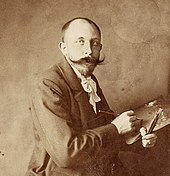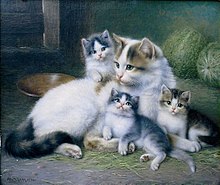Wilhelm Black
Wilhelm Friedrich Johann Schwar (born May 25, 1860 in Münster , † April 9, 1943 in Munich ) was a German painter who is best known for his depictions of animals, especially cats.
Life
Wilhelm Schwar was born as the ninth son of the whitewater Jodocus Bernard Schwar. He discovered his passion for drawing and painting at an early age, but began as a “clerk” (merchant's assistant) and worked as such in Hamburg since October 1884. At the same time, however, he devoted himself to his secret passion, painting, self-taught. A lost painting depicting a farmer with toothache is inscribed and dated Hamburg '84, W. Schwar . But just a year later in September 1885 he left Hamburg again and in October 1885 registered in the then artist stronghold of Munich to devote himself entirely to painting.
While he was doing his autodidactic studies in nature and on people, he got to know other young artists during this time. Together with Christian Heuser (1862–1942) and Gustav Köhler (1859–1932) he attended the painting school of Karl Rickelt (1857–1944) and in 1892 became a "full" member of the Munich artists' association .
From 1890 ("Funny Fellows") he exhibited almost regularly at the annual exhibitions in the Munich Glass Palace. In the following years he also sent the exhibitions of the art associations in Hanover (1894 card player, letter reader), Bremen (1894 "Siesta"), Berlin, Hamburg, Baden-Baden etc.
In 1892 he married Barbara Schmautz and in 1898, thanks to the successful sales of his paintings, he was able to set up a house on Kratzerstr. 40 in the parish of Gern (now part of Munich). The painter Julius Adam from the Adam dynasty lived in the neighborhood .
After devoting himself to the depiction of Landsknechten (funny journeymen, card players), still lifes (1891) and scenes from rural life (1894: scythe grinder, 1897: potato harvest) in the first years of his artistic activity, he turned to animal painting (dog , Chickens) and finally, due to the taste of the time or influenced by Julius Adam, whose cat paintings sold well, he also specialized in depicting cats at the end of the 1890s.
Also in France ( Eugène Lambert ; 1825–1900), Belgium / Netherlands ( Henriette Ronner-Knip ; 1821–1909), England ( Louis Wain ; 1860–1939), Austria ( Carl Reichert ; 1836–1918), Switzerland ( Théophile- Alexandre Steinlen ; 1859–1923, and even America ( John Henry Dolph ; 1835–1903) and Carl Kahler, who immigrated from Austria 1855–1906) memorialized the saloon tigers in their paintings and found an enthusiastic group of buyers.
Many cat paintings by Wilhelm Schwar made their way to America through the sale of his brother Bernard (* 1861, †?), Who emigrated to California, when they were not bought by American art lovers who were keen to travel at art exhibitions in Germany. For the general public, with whom the cat motifs were also very popular, his paintings were produced as art prints by the publishers Franz Hanfstängl, Munich and the Photographische Union, Munich in various qualitative versions. Theo. Stroefer's Kunstverlag, Nuremberg and other manufacturers of the picture and art postcards so popular around the turn of the century took over his motifs from cats and dogs, which were then sent on a journey into the world and kept in scrapbooks. In addition to catalogs, art prints and magazines, the postcard was an important medium for making the exhibited works known to a broad section of the population. His paintings of cats were also reproduced in the form of wood engravings in the “illustrated” family sheets “Die Gartenlaube” and “Über Land und Meer” and brought them closer to the readers in family circles and in lending libraries and cafés. The First World War not only ended the exhibitions in the art associations, but also the demand for his cat paintings. Although he exhibited in the Glaspalast in Munich until 1927 after the end of the war, the financial problems also increased due to the collapse of the currency. At almost 70 years of age, creativity also declined due to health problems. After the death of his wife in 1937 and in the turmoil of the Second World War, Wilhelm Schwar died in 1943 at the age of 83, lonely and forgotten. He is buried in the Westfriedhof in Munich, section 113-4-38.
Works
Munich, Städtische Galerie im Lenbachhaus, K 5180, “Vegetable Still Life”, 1892, 64 × 89 cm, oil / canvas, K 3871, “Dahlias”, 1929, 51 × 41 cm, oil / canvas. Wolverhampton, Wightwick Manor (National Trust Collections), inv. No. 1288969, "The Three Friends", 1898, 27.5 × 20.5 cm, oil / canvas.
literature
- Black, Wilhelm . In: Hans Vollmer (Hrsg.): General lexicon of fine artists from antiquity to the present . Founded by Ulrich Thieme and Felix Becker . tape 30 : Scheffel – Siemerding . EA Seemann, Leipzig 1936, p. 346 .
- Erich Scheibmayr: Last Home: Personalities in Munich Cemeteries 1784–1984. Scheibmayr, Munich 1989.
- Black, Wilhelm. In: Friedrich von Boetticher: painter works of the 19th century. Contribution to art history. Volume 2/2, sheets 33–67: Saal – Zwengauer. Ms. v. Boetticher's Verlag, Dresden 1901, p. 690 ( archive.org ).
- Bruckmann's Lexicon of Munich Art: Munich Painters in the 19th Century. Volume 4, Verlag F. Bruckmann KG, Munich 1983, pp. 122-123.
- Rudolf Presber: Dog and Cat in the Artist's Image. Julius Hoffmann Publishing House, Stuttgart 1921, p. 11.
- Ulrich Klever: Knaur's Large Cat Book. Droemersche Verlagsanstalt Th. Knaur Nachf., Munich, 1985, p. 150.
Web links
- Animal painting: Wilhelm Friedrich Johann Schwar catplus.de
- Wilhelm Schwar (German, 1860–1943) artnet.de
- Wilhelm Schwar ( Memento from September 24, 2015 in the Internet Archive ) haynesfineart.com (English)
| personal data | |
|---|---|
| SURNAME | Black, Wilhelm |
| ALTERNATIVE NAMES | Black, Wilhelm Friedrich Johann (full name) |
| BRIEF DESCRIPTION | German painter |
| DATE OF BIRTH | May 25, 1860 |
| PLACE OF BIRTH | Muenster |
| DATE OF DEATH | April 9, 1943 |
| Place of death | Munich |

